Music can be so fun for our little ones in speech, and even kids in general! And it’s a great way for them to practice their speech and language skills.
I have this big tub of instruments that one of my daughters received as a gift when they were little. They may just look like musical instruments, but I see so much more!
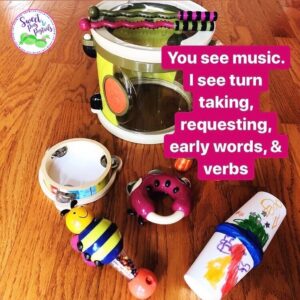
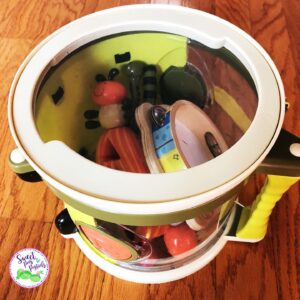
Music is so important. I started singing to my own children when they were babies. We went to baby story time and toddler story time where they incorporate lots of songs and finger plays and I’ve actually incorporated some of these songs into therapy with my little ones over the years. Some of my favorites include “Roly, Poly,” “Open Shut Them,” and “Walking Walking.”
I also love singing songs such as “Wheels on the Bus” and “Old MacDonald Had a Farm” in therapy and what I’ll do is sing it a few times through and pair it with toys if I have them on hand. Once the child knows the song, I’ll pause at one of the words (“and on his farm, he had a ______...”) for a few seconds, giving the child a chance to say the word. Sometimes they say it, sometimes they don’t, but I still like to give them that opportunity.
You can even make your own noise makers with older toddlers and preschoolers for a fun speech and language activity! All you need are two paper cups, some beads to put in the cups, craft tape to hold the cups together, and stickers. Have your kiddos request for the different items while putting the craft together and when it’s done, let them shake away! 😉 Shake them to music, sing your own song, shake them fast, shake them slow, shake them up and down… the possibilities are endless.
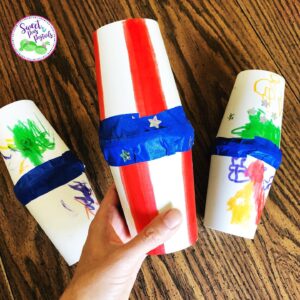
Do you use music in speech? If you would like some more fun speech & language activities to use with your little ones, check out my Teachers Pay Teachers Store!
This is one of my favorite all-time dog books! I read this book to my girls when they were younger and I will throw it in my therapy bag if I have a little one on my caseload. I’m always recommending Sandra Boynton’s books to friends who are about to have babies or to parents of children that I treat. If you have small children at home or on your caseload, and you’re looking to boost their speech and language skills, check this book out!
Below I’m going to share with you how I used this book with my own kids as well as the kiddos I see in speech. Hopefully you’ll be able to implement these ideas as well!
Did you know that animal sounds count as words?! Parents are often surprised when I tell them about this. In fact, if a child is not verbalizing or saying many words, I’ll often begin with a goal to produce animal sounds.
Now this book only has dogs in it (except for the surprise cat at the end), but each dog has a different bark! You can work on “woof,” “yap,” “ruff,” “bow wow,” “ar roof,” “arf,” “grrr,” “rrowff,” “aaaoooo,” and “raow.” So fun!
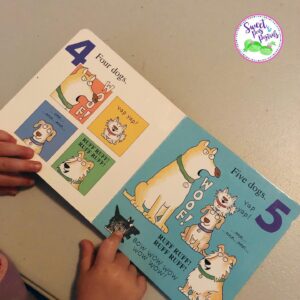
You can easily work on teaching basic concepts with this doggie book. The dogs pictured are different sizes and colors, and some have long hair while others have short hair. We also sometimes work on quiet/loud by saying our doggie sounds with a quiet voice and then with a loud voice… the kids get a kick out of that one!
I have a confession. I don’t just use this book with toddlers and young preschoolers. I sometimes use it with five-year-olds that struggle using plurals. When teaching plurals, I often show one of an item (one pen or one toy) and then find the same item so I have two things. I usually say something like “here is one pen, here are two pens,” emphasizing the sound at the end of the word.
With this book, you can have your children count the dogs on each page and tell you how many dogs they see. If they leave off the ending sound to make a plural, repeat it back to them correctly, emphasizing the ending sound.
There are plenty of sounds that you can target in this book- just scroll back up to point number two and take a look at all the different barks produced by the various dogs in the book!
Articulation, or how the child produces their sounds, is very important, don’t get me wrong. However, when children are young, building vocabulary is more important because you need language for functional communication.
While you are reading this book with your child, do emphasize and exaggerate the different sounds and make sure they can see your mouth. Who knows, he or she might surprise you and “bark” like one of the doggies, especially if you are reading the book over and over.
If you have a two- or three-year-old with good language skills, definitely see if they can imitate the /d/ sound as that is a sound that they should be able to produce at that age.
We homeschool, and when the girls were preschool age, we of course worked on learning letters and numbers. This book is perfect for teaching the letter “D” as you can have your child look for all the “D’s” in the book. We then would talk about what sound “D” makes and then talk about how “dog” has that sound. After that, we would try to think of other words that start with that sound.
This book also inspired us to make a craft! This would be a fun project for your little ones at home or in speech while you read the book. 😊
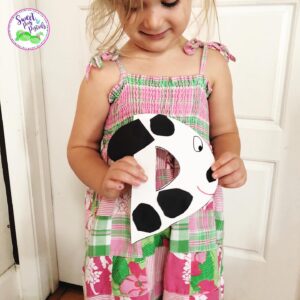
Let me know if you have read this book in speech therapy or with your little ones at home. I’d love to hear how you use it! If you would like some more fun speech & language activities to use with your little ones, check out my Teachers Pay Teachers Store!
I’m a pediatric speech therapist and also a mom and I absolutely love talking to parents about ways they can help their children communicate. One strategy I talk about often is communication temptations.
Communication temptations is a strategy where you structure or manipulate the environment so the child must use communication in order to receive the desired item. I use communication temptations often in my own therapy sessions and also used them with my daughters when they were little and learning how to talk.
Fun Ways to Build Early Language Skills with Communication Temptations
Listed below are some fun ways you can tempt your kids to communicate. Use these ideas to motivate your children to express their wants and needs as well as give them an opportunity to initiate communication.
Things to Keep in Mind When Using Communication Temptations
Do you use communication temptations with your kids? I’d love to hear how you use them! If you would like some more fun speech & language activities to use with your little ones, check out my Teachers Pay Teachers Store!
I admit that I actually didn’t know who Sandra Boynton was until my oldest daughter was about to turn one. At that point, I had already been a speech-language pathologist for eight years!
Right before her first birthday, I began researching books to use with her to build her speech and language skills. This was one of the books that popped up and she ended up getting this book along with some other Sandra Boynton books for her first birthday.
If you have little ones at home or on your caseload, and you are looking to build speech and language skills, this book is a must!
So, what are some things you can work on with this book? I’m glad you asked! Here are some ways I incorporated this book with my own children as well as the kiddos on my caseload:
There are lots of pictures of animals in this book, including a cow, duck, horse, sheep, pigs, rhinos, dogs, and cats. First see if your child can point to the picture of the animal that you name. Then when he or she is successful with that task, see if they can name the animal when you point to it!
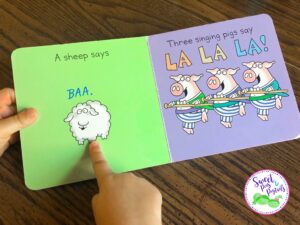
Did you know that animal sounds can be counted as words? As I’m evaluating children for speech and language delays, I’ll often ask parents approximately how many words they think their child may speak. Oftentimes animal sounds are not counted in the total number, but when they hear that their child is actually saying a few more words than they thought, it brings some encouragement.
This book is perfect to practice those animal sounds (hence the title 😉). Work on moo, baa, neigh, ruff, bow wow, meow, oink, etc. Sometimes I’ll sing a song to the tune of “Wheels on the Bus” with this book: “the cow on the bus says moo, moo moo, moo, moo, moo, moo, moo, moo, the cow on the bus says moo, moo, moo, all through the town.” The kids always seem to enjoy this activity!
You can easily sneak in some basic concept practice with this book! I usually work on teaching big/little (the dog is little and the rhino is big) and same/different (a sheep and a pig are different), etc. We also sometimes work on quiet/loud by saying the animal sounds with a soft voice and then with a loud voice… the kids get a kick out of that one!
I like to describe to my kids what the animals are doing. The book displays the animals performing simple actions such as standing, running, singing, and dancing. Sometimes we’ll get our bodies moving and perform the actions ourselves! If you are a parent or you work with kids, you know movement is a must with little ones!
Have you read this book in speech therapy or with your little ones at home?! I’d love to hear how you use it! If you would like some more fun speech & language activities to use with your little ones, check out my Teachers Pay Teachers Store!
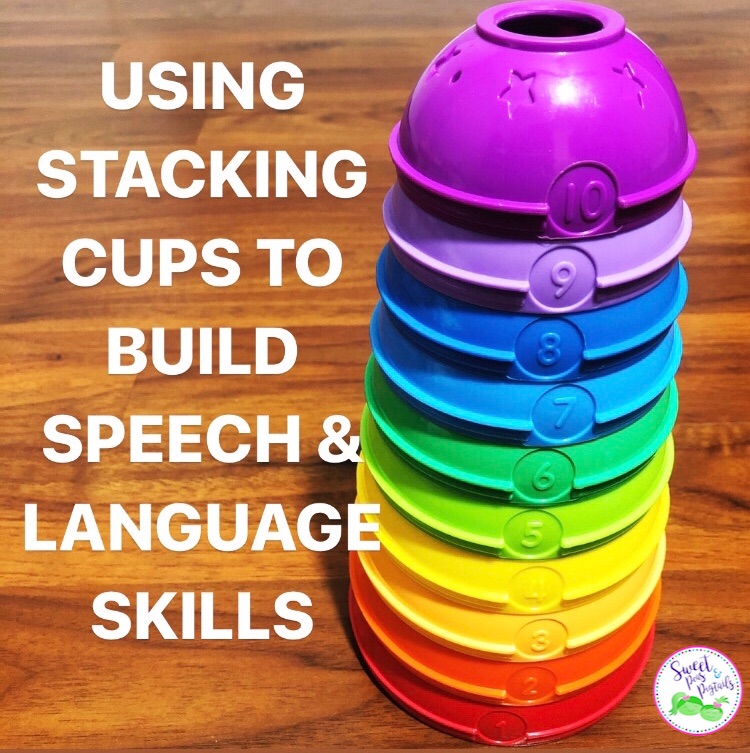
I bought these stacking cups for my oldest daughter for her first birthday back in 2015. Now that she is five and a half and little sister is three and a half, I thought maybe it was time to donate the toy. After all, it was tucked away in a toy bin and the girls hadn't played with it in awhile.
As I went to put it into the donate pile, I thought maybe I could use it in speech therapy with my young preschool kids. With all of the different colors and the different ways it comes apart and snaps together, I just could not part with it. I knew I could target tons of goals so I placed the toy in my therapy bag.
And wouldn't you know, these stacking cups were a HUGE HIT with my kids! And even my youngest daughter found them in my bag and started playing with them again! This simple toy is not just a baby toy; you can get lots of use out of it in your sessions! Read on to see how I used it in my sessions!
So many basic concepts to target! I like to use them to work on size, color, and negation concepts.
-Stack the cups and make big moutains and little mountains
-Bring out toy animals and have them climb up and down the big/tall/little short mountains
-Flip the cups over to make pools and have the animals swim in the different color pools
-Break apart the cups and ask the child, "Give me the cup that is not ____ (big, purple, little, etc.)
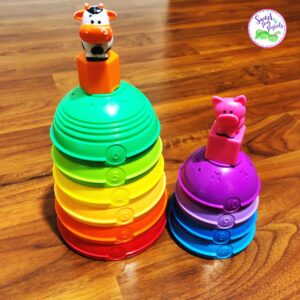
This is such an easy toy to target preposition goals!
-Stack the cups on, take the cups off
-Put the animals on top/in/under the cups
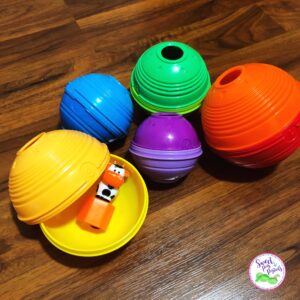
Need to target verbs? No problem!
-Climb mountain
-Jump in the pool
-Swim in the pool
-Splash the water
-Snap the cups into balls and then roll them back and forth
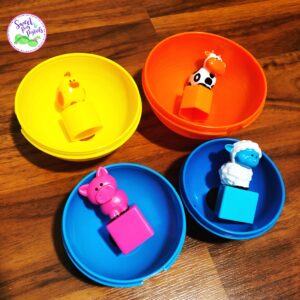
I'm always working on following directions with my kiddos! This is an easy way to sneak it in!
-Tell the child to hide an animal under a certain cup (Hide the cow under the orange cup)
-You can increase the number of steps depending on the child's ability (Hide the cow under the orange cup and then give me the blue cup, etc.).
If you do pair the cups with animals or little dolls or figurines, you can totally target WH-questions!
-Ask the child, "Who is in the blue pool?" "Who climbed up the mountain?"
-Hide the animals under the cups and ask, "Where is pig?", etc.
I have literally used these stacking cups for entire 30 minute sessions with young preschoolers. I am so glad that I did not donate it and that I decided to hang onto it! And now my daughter has something "new" to play with!
Have you used stacking cups in speech?! I'd love to hear!
(This post contains Amazon Affiliate links which means if you purchase something using my link I may make a small commission)
Summer is in full swing and we are enjoying every bit of it! I’m a mom to two little girls, an almost three-year-old and an almost five-year-old. I’ve also worked as a speech language pathologist for over 13 years. Ever since my girls were born, I’ve loved incorporating easy, fun activities to build their speech and language skills. This is the first summer that I am not working since I began my career as an SLP and I wanted to share with you some of the activities that have kept us busy so far this summer, all while building my girls’ speech and language skills!
My girls and I love being outside, so this was such a fun activity for us. I just grabbed some paper bags and a sharpie and we brainstormed some things that we might find outside. I then wrote them on the bag and off we went! Not only did the girls have a blast, but there was so much language learning going on with this activity: categories (these are insects, those are flowers, etc.), basic concepts and describing (the butterfly is yellow, the rock is hard, the stick is long and thin, etc.), and comparing/contrasting (that leaf is brown and this leaf is green).
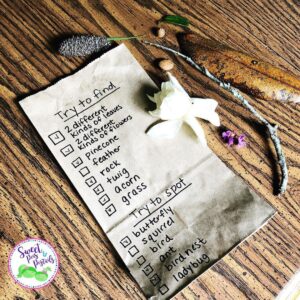
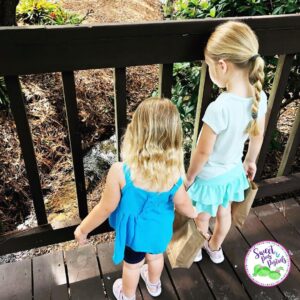
Three summers ago, when my oldest daughter was just a toddler and I was seven months pregnant with my youngest daughter, my husband built a water table. The girls love playing with it every summer and I love that you can target so much speech and language with a fun activity like this. We usually throw in our flamingo floats, some bath toys, balls, cups, and scoopers, and the girls entertain themselves!
You can teach a ton of language-rich vocabulary during this activity: splash, pour, scoop, float, sink, full, empty, wet, dry, spill, soak, squirt, and swim. This activity is also great for requesting and social skills (taking turns, sharing toys, etc.), especially when the little neighbor friends come over to play.
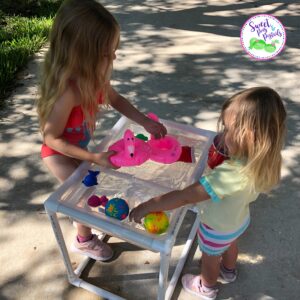
Every week, we visit our local public library for story time. It lasts about 20 minutes and it is jam-packed with so many fun activities from singing songs to puppet shows to listening to the librarian read a story. Afterwards, the girls head over to the children’s section for some playtime with the other kids.
My girls love going to the library and checking out stacks of books. Most libraries have summer reading programs for children to participate. At our library when you sign up, you get to choose a free book. Then we received a packet full of ideas and activities to work on at home. Story time is definitely something I recommend year-round to parents with little ones, and if you can’t make it during the week, some libraries offer Saturday programs.
For Independence Day, my girls and I spent some time making our American flag fruit dish which consisted of blueberries, strawberries, and marshmallows. I started making this with my oldest when she was just a toddler and when I was pregnant with my youngest and ever since it’s been our little tradition. It’s so easy to make and it’s the perfect summer dish!
My girls love helping in the kitchen and I love all the language learning that takes place: sequencing (first we are going to rinse off the strawberries, then mom will cut them, then we will put them in the dish), following directions (put the blueberries in the dish then put the strawberries in), turn taking (the girls each took turns putting fruit/marshmallows in the dish), attention, describing (the blueberries feel squishy, my hands are wet, etc.), and spatial concepts (the marshmallows go under the strawberries, etc.).
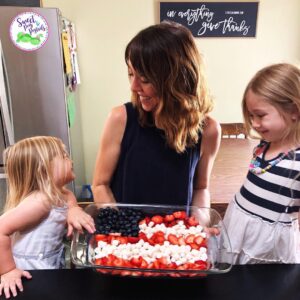
My four-year daughter has been getting into games recently. Her current favorites are Go Fish, Memory and Candyland. She asks me often to play these games with her, so I’ll play with her for a little while during the day since her little sister isn’t quite big enough to play by herself yet.
Did you know that while playing games, kids are practicing social skills such as turn taking and making eye contact? And not just that! They’re also learning basic concepts (colors, size, shapes, numbers/counting, etc.), and following directions. For example, when you play a memory matching game, you are trying to find cards that are the same. Cards that are not the same are not matches.
This opens up lots of discussion such as talking about how they are different or maybe the pictures are the same color but they are different fish for example (a blue shark and a blue dolphin). We then go on to count our matches and figure out which person has the most cards. These are important math skills for children to grasp.
So, pull out the card and board games and get playing with your children on those rainy or too hot to play outside days! You are building great language skills in your children when you do!
Did you know that some craft stores offer free crafts for kids?! We are lucky enough to live close to a Lakeshore Learning store and on Saturdays they have a kid’s craft time. On one of the Saturdays we went, the girls made noisemakers! They had a blast and didn’t even realize they were practicing some skills such as requesting for the colors/stickers they wanted on their cups, asking for help if they couldn’t tape the cups together by themselves, following directions (put 5 beads in the cup, etc.) and waiting their turn if someone else had the color marker they wanted. We definitely plan on going again in the future.
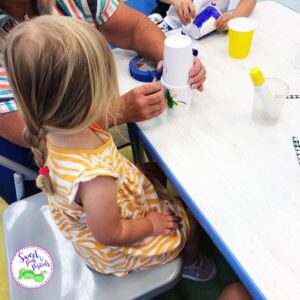
If you don’t live near a Lakeshore Learning store, I’ve heard that Michaels offers 30-minute crafts for children ages three and up on Saturdays and Home Depot offers free workshops for kids on the weekends. Make sure to check with your local stores to see the activities they offer!
The park is a wonderful place to promote speech and language skills. I started bringing my children to the park when they were just babies. I remember when my husband and I were brand new parents and we would take our new baby on long walks every evening to unwind. By the time she was able to sit on her own, we started putting her in the baby swing at the park. Let me tell you, there is SO much language you can target just on the swing, and not just for babies, but toddlers and preschoolers too!
I always tell parents to narrate their days while talking with their babies and children. The more words a child hears, the better! They might not be able to talk back yet, but they are listening. So with my baby, when I put her in the swing, I might say, “I’m putting you in the swing.” “You’re such a big girl!” “The swing moves back and forth.” “I’m going to stop the swing.” You get the idea!
For toddlers, I might say “Ready, set…” and pause before saying “go” and let them say the word. I also might stop the swing and see if they will sign or say “more” and then repeat the “Ready, set, go” again. We also work on “stop”, “fast”, “slow”, “high”, “low”, and “in” and “out” when getting in and out of the swing. And with both toddlers and preschoolers, you can always work on turn taking when there is only one swing.
And of course, you can go to any park! No playground equipment is required. We enjoy taking the girls to a local park that has a walking trail around a lake and we talk about the ducks and turtles we see. There’s something about getting out in nature that is so relaxing for us!
Well there you have it! I hope this gave you some ideas for some summer activities, and if you have one to add, I’d love to hear it!
Be sure to check out my TpT store for more fun speech and language activities you can use with your child.
Speech therapy does not have to be fancy to be effective. While working with children and being a mommy to two little ones of my own, I’ve found that kids are motivated by the simplest things! I’ve also found that using common items unconventionally with my kids keeps them very engaged! Read on to find simple, no prep activities to help keep your kids interested during your sessions.
All you need is a plastic cup for each child, a dice, and a bunch of mini erasers! Take turns rolling the dice and then put that many erasers in your cup and the person with the most erasers at the end is the winner! This activity was super fun and engaging and required no prep at all! We used it to work on counting, turn taking, prepositions (in/out), colors, articulation, basic concepts (more/less, full/empty), naming items (bunny, egg, basket, carrot, etc.), and increasing utterances (I got purple bunny).
I used my spring mini erasers for this activity but it would be fun to change it up for all of the seasons and holidays with different mini erasers! You could also play this game in between articulation cards and maybe have the child roll the dice and then say their word that many times and then continue on to fill their cups with that many erasers. The opportunities are endless!
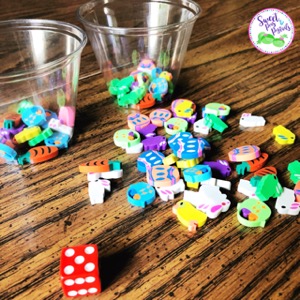
Here is an example of using a toy in an unconventional way! Turn a few mega blocks upside down. Have the child say their word and then roll the dice to see how many pom poms (or mini erasers, magnetic chips, paper clips, etc.) to put in the blocks! Continue until all blocks are filled or all words have been said!
Of course, you also get in some prepositions, color sorting, and fine motor practice with the tweezers! I paired this activity with my Apraxia flashcards and it was so much fun!
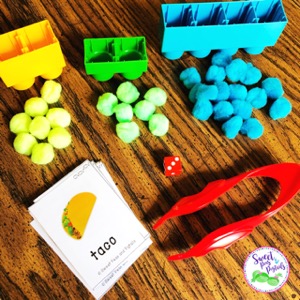
We go through a TON of almond milk in my house. We make smoothies every morning for breakfast so I use about five cartons of milk a week between me and my family. I thought it would be fun to save the lids and see if I could create something for speech! I saved up a bunch and actually made these sticker lids with a pack of stickers I got from the Target Dollar Spot. These stickers are summer-themed but again, you can make new ones for each season or holiday to change it up a bit!
For this activity, I just grabbed a sheet of paper and a marker and made up sentences. The child then places the lids under each sentence. This activity is great for describing, prepositions, basic concepts, and following directions. You can also reverse the roles and have your student give you the directions! If you want to make the activity more complex, add a few steps to the directions: “Knock on the door after you put the purple octopus under your chair!” or “Put the orange shell on top of the pink starfish before you stomp your feet!”
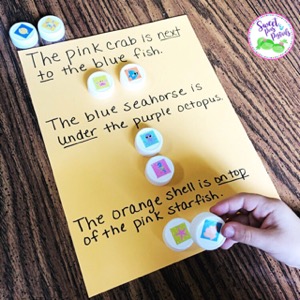
I always seem to have tons of boxes at my house, thank you Amazon Prime! If you’re constantly ordering on Amazon like we are, then put all of that cardboard to use! We made lacing shapes by just cutting out basic shapes and then punching holes around the shape. Have your child decorate each shape with crayons and/or stickers and grab an old shoelace and you are set!
Target articulation (initial /l/ and final /s/ in “lace” and final /ch/ in “punch”), prepositions (lace through the hole and over/under), and requesting (request items for decorating their shapes). And of course, this activity is great for fine motor skills!
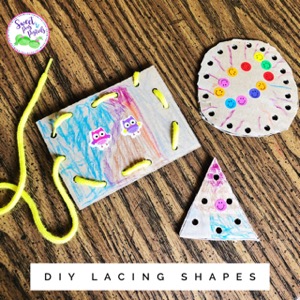
For this activity, you need a Ziploc bag and some pom poms. I printed my Preschool Vocabulary Smash Mats two to a page (printing half size is my new favorite thing!) and then laminated them and put them in the bag with the pom poms. We then pushed the pom poms (aka “gumballs”) around to each picture and then named each picture! I love that it puts a different spin on an activity we use a lot!
This activity is perfect for travel therapy and for throwing into the diaper bag for your kids to do while waiting at the doctor or at restaurants!
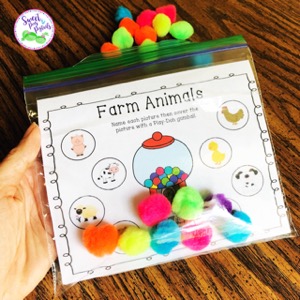
How do you keep your kids engaged in your speech therapy sessions?! I’d love to hear!
Check out my Teachers Pay Teachers Store for more fun speech & language activities!
It can be extremely hard to keep little ones engaged during your speech sessions! Today I’m sharing my favorite ways to keep children engaged during therapy. And I’m all about easy, so you can start implementing these activities today!
Sensory bins are basically containers filled with different sensory materials to stimulate the child’s senses (see, hear, touch, taste, and smell). They are so much fun in speech! Pictured below is one of my favorite sensory bins. I attached paper clips to the cards, filled the bin with blue shredded paper for the “water” and the kids fished for verbs while playing bingo. My smaller kids worked on pronouns, naming actions, and possessives while my older kids worked on verb tenses, rhyming, and grammar. I usually like to center my bins around the holidays or seasons so the kids definitely look forward to all of the different bins.
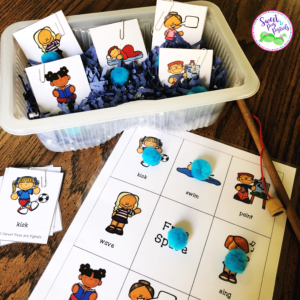
Have you ever used smash mats in therapy?! They are a hit with my kids! We usually use Play-Doh, but sometimes we cover the pictures with mini erasers or pom poms to change it up a little. And other times, I’ll break out the bingo chips & the magic wand!
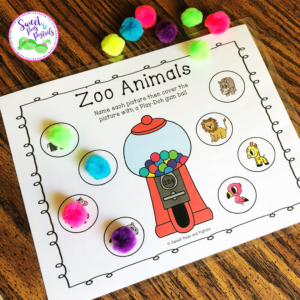
Little ones definitely need movement from time to time so they can stay focused. One way I incorporate movement is by writing actions on popsicle sticks while targeting following directions. The child draws a stick (or two!) and then performs the action(s) (hop to the door, etc.). I also use my themed following direction cards a lot during my sessions which always are a hit!
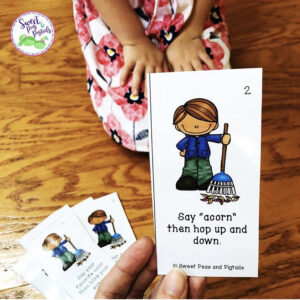
Another easy way to get your children up and moving is by using books! Some of my favorites to get those wiggles out are Barnyard Dance by Sandra Boynton and From Head to Toe by Eric Carle. And, you can target a variety of goals while reading the books, so it’s a win-win!
I always make sure to have puzzles with me in my sessions! To incorporate fine motor into my sessions, sometimes I wrap the puzzles pieces in foil and throw them into a sensory bin with flash cards. In between cards, my kids get to choose a puzzle piece to unwrap as they work towards building the puzzle!
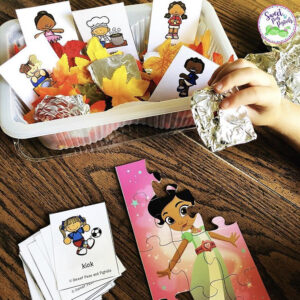
Or sometimes we just keep it super basic and throw the pieces in the bin without flash cards! With this puzzle, we work on prepositions (in/out), requesting for more, asking & answering yes/no questions (“is it a snake?”), naming animals & their sounds, describing, and articulation. Sometimes we also hide the pieces around the room and work on asking/answering “where” questions (“zebra, where are you?”).
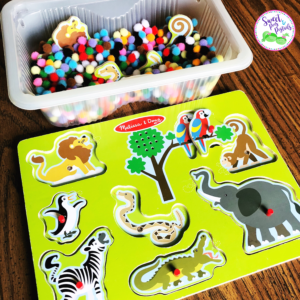
How do you keep your kids engaged in your speech therapy sessions?! I’d love to hear!
Check out my Teachers Pay Teachers Store for more fun speech & language activities!
(This post contains Amazon Affiliate links which means if you purchase something using my link I may make a small commission)
For the past few years or so, I’ve been incorporating sensory bins into my speech therapy sessions. My daughters also enjoy playing with mama’s sensory bins at home. Using a sensory bin is a great way to build speech and language skills and it definitely makes my therapy sessions more fun and exciting for my little ones (and even for some of my older kiddos)!
Sensory bins are basically containers filled with different sensory materials. They are created to stimulate the child’s senses (see, hear, touch, taste, and smell). The first thing you need to do is find a bin to use. Sometimes I use a Sterilite plastic bin with a lid but I’ve also used any containers or bins that I may have around the house. Then, choose a filler for inside the bin. I usually like to center my bins around the holidays or seasons so that determines which filler I choose. For winter, I like to use cotton balls for “snow” and for spring, I like to use Easter grass or beans. In the summer, I usually use kinetic sand or blue shredded paper for “water” and in the fall I picked up some silk leaves at the dollar store that worked really well! The possibilities for fillers are endless!
Sensory bins are so much fun in speech! I love throwing any type of flashcard into a cotton ball sensory bin during the winter season! Pictured here are my s-blend snowmen flashcards! We pull them out, say our word, and then cover the picture with a “snowball” (white Play-Doh or a cotton ball). It’s so much fun!
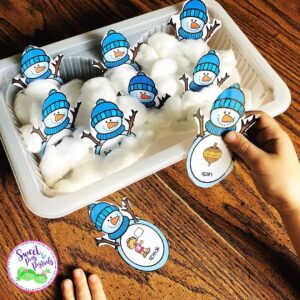
In the spring, I like to use Easter grass and for this particular bin, I hid spring-themed mini erasers inside. Here, we were playing Easter Preposition Bingo, and then after the students took their turn, they got to search for a mini eraser in the bin and put it on their bingo board!
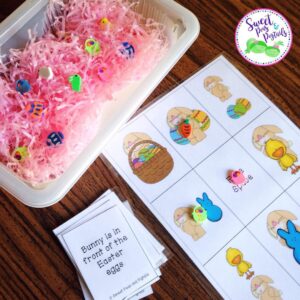
Pictured below is an example of a summer-themed sensory bin. I filled it with blue shredded paper for the “water” and the kids loved fishing for verbs while playing bingo. My smaller kids worked on pronouns, naming actions, and possessives while my older kids worked on verb tenses, rhyming, and grammar.
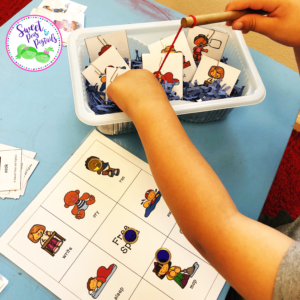
My fall sensory bins typically have popcorn kernels or dollar store leaves. For this bin, the kids pulled out the calling cards and then used black & white bingo game boards with dot markers for the pictures because we are a little obsessed with those too. 😊
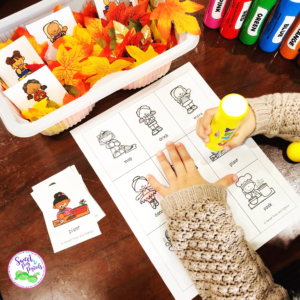
Of course, you can throw anything into your bins, it doesn’t just have to be flashcards! Throw in little objects or toy people! Work on prepositions such as in/out, on/off, under/over, etc. Target verbs (open/close, scoop, dig, etc.) while playing with the sensory bin. The kids won’t even know they are working!
Do you use sensory bins in your speech therapy sessions?! I’d love to hear! Check out my Teachers Pay Teachers Store for more fun speech & language activities!
(This post contains Amazon Affiliate links which means if you purchase something using my link I may make a small commission)
We made it to winter, friends! We’ve had some pretty cold days here in Central Florida so far this year (well, cold by my standards-ha ha!), but currently we are right around 80 degrees, which I’m pretty happy about. Give me a few cold days during the holidays but come January, I’m ready for some warmer temps (I would never survive up north!). Even though it’s warm here, we still try to incorporate a little winter into our sessions. Read below to see my favorite ways!
I love incorporating winter games during my sessions. An oldie but a goodie (and one of my all-time favorite therapy games!) is Don’t Break the Ice! This game is perfect for the little ones and I’ve even had some 5th graders enjoy playing it! I use this in between turns while targeting our goals as well as use it to target different areas such as turn taking, requesting (I want the yellow stick), articulation (especially final /s/ in “ice”), and vocabulary.
We are all about “snow” in speech since we don’t get snow here! We’ve been using a lot of white Play-Doh in our sessions on my snowball-themed apraxia smash mats! I use these mats to target apraxia and articulation delays and the kids love making “snowballs” after they say their words!
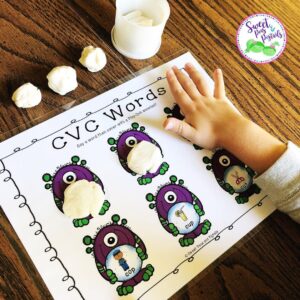
I’m all about sensory bins in my sessions! And how cute is this bin?1 I love throwing any type of flashcard into a cotton ball sensory bin during the winter season! Pictured here are my s-blend snowmen flashcards! We pull them out, say our word, and then cover the picture with a “snowball” (white Play-Doh or a cotton ball). It’s so much fun!

We love anything snowman this time of year! Here is an easy melted snowman craft that is perfect for speech! It is fun to pair with the book, Sneezy the Snowman by Maureen Wright. I love incorporating crafts into my sessions because you can target so many speech and language skills. Work on requesting for the different materials, vocabulary, verbs (glued, cut, etc.), colors, and categories (clothing, body parts, etc.).
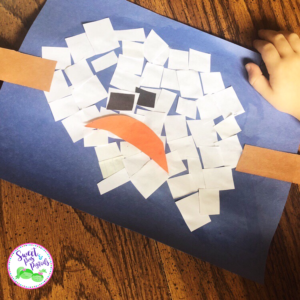
My kids love these winter-themed articulation spinner worksheets. I literally have all of these worksheets in a notebook and make copies when needed. I’ve also sent them home for homework. The packet includes winter-themed game spinners with 5 articulation target sounds on each spinner. We love dotting our pictures with dot markers after we say our words.

You can try the initial /th/ sound for FREE here!
How do you incorporate winter into your speech therapy sessions?! I’d love to hear! Check out my Teachers Pay Teachers Store for more fun winter speech & language activities!
(This post contains Amazon Affiliate links which means if you purchase something using my links I may make a small commission)